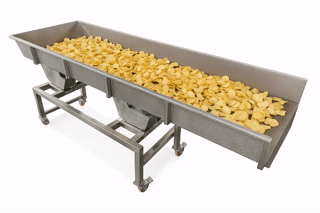Linear Vibratory Feeder | Efficient Feeding
What is Linear Vibration Feeder
The Linear Vibratory Feeder—also known as Vibratory Linear Feeder or simply Linear Feeder,Fast back —is a high-performance material handling solution engineered for precise, continuous, and uniform feeding of loose solid materials.
Unlike common misconceptions, this feeder isn’t designed solely for fragile items like potato chips. It excels in feeding a wide range of free-flowing or non-sticky bulk materials, such as puffed snacks, granules, grains, plastic pellets, small hardware parts, and more.
Its linear vibration design enables smooth movement, reliable control, and consistent discharge rates—making it a top choice across industries including food processing, packaging, plastics, chemicals, and electronic
Technical Specifications
| Feature | Specification |
|---|---|
| Body Material | SUS304 Stainless Steel |
| Tray Design | Flat / V-shaped / U-shaped (customizable) |
| Feeding Volume | Adjustable depending on tray width and material type |
| Power Supply | 220V 50Hz / 60Hz 1Ph / 3Ph |
| Drive Mechanism | Electromagnetic or Motorized Vibration |
| Vibration Frequency | 50–100Hz (adjustable) |
| Amplitude | 1mm–3mm (tunable) |
| Control System | Variable Frequency Drive (VFD), optional sensor-based control |
| Installation Type | Stand-alone or frame-integrated |
| Hygiene Compliance | Food-grade surface finishes, easy to clean, open-frame design |


Applications
The versatility of our Linear Vibration Feeder allows it to be used in various industries, providing precise and efficient material handling solutions. Here are some common applications:
- Packaging Industry: Seamlessly feeds components into packaging machines, enhancing the speed and efficiency of packaging processes.
- Automotive Industry: Precisely positions parts on assembly lines, improving accuracy and productivity.
- Electronics Industry: Handles delicate electronic components with care, ensuring no damage during the feeding process.
- Pharmaceutical Industry: Maintains the integrity of pharmaceutical products by providing a gentle and controlled feeding mechanism.
Key Features & Benefits
✅ Handles All Loose Solids: From dry grains to puffed snacks and plastic pellets.
✅ Precision Feeding: Stable flow rate for synchronized downstream packaging.
✅ Energy Efficient: Low power consumption due to direct vibration drive.
✅ Customizable Layouts: Tray shapes, lengths, vibration controls to fit any line.
✅ Hygienic and Durable: Built to meet food industry standards with corrosion-resistant parts.
✅ Quiet Operation: Low-noise motors suitable for indoor production floors.


Vibrating Feeder Working Principle
The Linear Vibratory Feeder operates based on the principle of electromagnetic or motor-driven vibration, designed to achieve a uniform and controlled flow of bulk solid materials. Its modular structure consists of carefully engineered components that work in sync to create linear movement, enabling gentle, stable, and consistent feeding.
Key Components & How They Work
Base Unit
Provides stability and absorbs vibration, protecting the frame and minimizing transfer of force to the floor.
Coil and Magnet (Drive System)
The electromagnetic coil generates vibrations that move the tray back and forth rapidly, causing materials to hop forward.
Springs
Connect the tray to the base and help transfer vibration efficiently while allowing controlled movement.
Feeder Tray
Holds the product and channels it in a consistent line as it vibrates. The shape and length are customizable for your product needs.
Control Button
Simple on/off control—no PLC required. Operators manually control operation, ideal for straightforward production setups.
Linear Vibration Design: How It Adapts to Your Material and Workflow
The effectiveness of a linear vibration design depends on how well it’s tailored to the specific characteristics of the material being handled and the requirements of the production process. This design is never one-size-fits-all—it must be engineered with the following key factors in mind:
-
Material Characteristics: The size, shape, moisture content, density, and flowability of the product all affect how it responds to vibration. For example, lightweight puffed snacks require lower amplitude and gentler motion, while dense pellets need stronger vibrations.
-
Required Throughput (Feeding Capacity): The design must match your target feed rate. Higher output volumes may require wider trays, higher vibration frequency, or a dual-lane configuration.
-
Application-Specific Requirements: Whether the feeder is used for metering into weighers, transferring between machines, or delivering product to a packaging line, the design must suit the application’s layout and integration points.
-
Tray Geometry and Surface: The tray must be designed to suit the material—flat for dry goods, U-shaped for granular flow control, or coated for slippery items.
-
Mounting and Isolation Design: Proper vibration damping and structural support are needed to maintain consistent performance and prevent interference with surrounding equipment.
By carefully balancing these elements, a linear vibratory feeder with optimized linear vibration design can deliver maximum efficiency, reduce downtime, and ensure smooth, controlled feeding for any type of loose solid material.

The feeder can handle a wide range of materials, including bulk solids, powders, granules, and small parts.
Yes, our Linear Vibration Feeder can be customized in terms of size, design, and configuration to seamlessly integrate into your production line.
Industries such as packaging, automotive, electronics, and pharmaceuticals benefit significantly from using our Linear Vibration Feeder.
The feeder uses advanced vibration technology for precise control over the feeding rate and positioning of materials.
The feeder is designed for low maintenance, requiring minimal servicing to ensure smooth operation.
Yes, the feeder is designed to operate efficiently in temperatures ranging from -10°C to 50°C.
The feeder is designed to be energy-efficient, reducing power consumption and minimizing environmental impact.
Fill Package offers comprehensive support, including installation assistance, maintenance services, and troubleshooting to ensure optimal performance.

